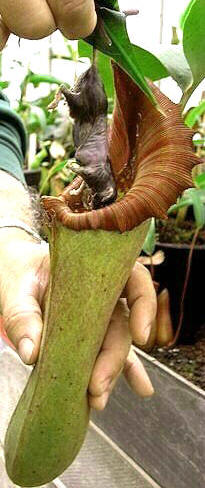
January 28, 2008

Remember the recent story of the discovery of a rat-eating pitcher plant? Do they or don’t they? Rats! Or not?
It sure kicked up a few pro and con feelings about the whole issue.
Some people wondered if pitcher plants can actually “eat” (i.e. dissolve and digest) rats?
Despite scientific literature saying it happens, skeptics exist.
Are the rats really mice?
Interesting distracting question, sort of like, how many times a week do you beat your husband?
How many rodents are eaten by your local neighborhood pitcher plants? Are rat-eating pitcher plants only found in Australia?
Do rodents actually fall for the pitcher plant traps?
How many rats does a rat-eating pitcher plant eat if a rat-eating pitcher plant actually eats rats?
Do the rat-eating pitcher plants really eat otters?
Have rat-eating new species been photographed on Mars?
Humm. Have I opened a whole can of rats?
To throw more data your way, here are some more pieces of the puzzle.
There are currently over 60 described species of rats in Australia, and they occupy a wide range of the habitats across the country. The majority of these are native species; however two rats (Black Rat and Brown Rat) are introduced species that have rapidly adjusted to Australian conditions.Animalcontrol.com
Additionally, below, here are a couple videos apparently giving visual proof of the interactions of rodents and pitcher plants.
Warning: Viewing these videos while eating may be hazardous to your keyboard, for vomiting my occur in rare cases. You have been warned and Cryptomundo will not be responsible for replacement costs.
These are followed by the comments of a German Cryptomundo correspondent who starts out with a negative stance on parts of the “rat-eating” issue. I’m not sure where he ends up, however.
There are always two sides, at least, to a story. Nature will find a way.
The following was forwarded by the German Sordes [I have noted my helpful English-language edits in brackets]:
^^^^^^^^^^^^^^^^^^^^^^^^^
This whole rat-eating-thing is nothing but [the] hype of journalists. I’ve been cultivating carnivorous plants of many kinds [for] many years, and own also a big personal “library” about this topic. In general, carnivorous plants don’t catch vertebrates at all.
The only vertebrates which are trapped comparably often (and that’s still rare) by some carnivorous plants are small frogs and small lizards. But normally they catch only insects. Only in extremely rare cases [do] a handful of very large pitcher plants trap small mammals, mainly climbing rodents. But this is only by chance, not because the plant “want” to catch them. Bigger prey, and this means already bigger insects like crickets, often begin to rot from the inside before the plant can digest it. The result is that the whole pitcher rots too.
In the case of small mammals, this is always the case. Such incidents are always accidents, for both, the mammal and the plant.
Furthermore, there are no real native rats in Australia, only some native mice. It is also highly [improbable] that this pitcher plant with its very slender pitchers and the short stem could ever catch a mammal.
There are some alleged reports of cryptid monster plants, mainly from the time around 1900. But they are all with nearly 100% chance only made-up tell-tales, especially the report from Madagascar. It describes a tribe which is nowhere else mentioned, and which is acording to the description much too primitive in contrast to the other folks of Madagascar, which were mainly farmers and fishers. The whole story stinks, and the way the woman was said to be eaten is also extremely [improbable].
BTW, there are NO fossils of giant carnivorous plants. In the whole there are only very few fossils of plants at all, because they only rarely fossilize. As far as I know there are only some fossil pollen of Aldrovanda versiculosa known.
Sordes
^^^^^^^^^^^^^^^^^^^^^^^^^^
Okay, Cryptomundians, what do you think? You be the judge.
About Loren Coleman
Loren Coleman is one of the world’s leading cryptozoologists, some say “the” leading living cryptozoologist. Certainly, he is acknowledged as the current living American researcher and writer who has most popularized cryptozoology in the late 20th and early 21st centuries.
Starting his fieldwork and investigations in 1960, after traveling and trekking extensively in pursuit of cryptozoological mysteries, Coleman began writing to share his experiences in 1969. An honorary member of Ivan T. Sanderson’s Society for the Investigation of the Unexplained in the 1970s, Coleman has been bestowed with similar honorary memberships of the North Idaho College Cryptozoology Club in 1983, and in subsequent years, that of the British Columbia Scientific Cryptozoology Club, CryptoSafari International, and other international organizations. He was also a Life Member and Benefactor of the International Society of Cryptozoology (now-defunct).
Loren Coleman’s daily blog, as a member of the Cryptomundo Team, served as an ongoing avenue of communication for the ever-growing body of cryptozoo news from 2005 through 2013. He returned as an infrequent contributor beginning Halloween week of 2015.
Coleman is the founder in 2003, and current director of the International Cryptozoology Museum in Portland, Maine.
Filed under Breaking News, Cryptobotany, Cryptomundo Exclusive, Cryptotourism, CryptoZoo News, Cryptozoology, Evidence, Eyewitness Accounts, Forensic Science, New Species, Videos